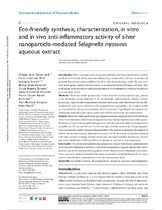| dc.contributor.author | Kedi, Philippe Belle Ebanda | |
| dc.contributor.author | Meva, Francois Eya’ane | |
| dc.contributor.author | Kotsedi, Lebogang | |
| dc.contributor.author | Nguemfo, Edwige Laure | |
| dc.contributor.author | Zangueu, Calvin Bogning | |
| dc.contributor.author | Ntoumba, Agnes Antoinette | |
| dc.contributor.author | Mohamed, Hamza Elsayed Ahmed | |
| dc.contributor.author | Dongmo, Alain Bertrand | |
| dc.contributor.author | Maaza, Malik | |
| dc.date.accessioned | 2019-08-05T07:42:45Z | |
| dc.date.available | 2019-08-05T07:42:45Z | |
| dc.date.issued | 2018 | |
| dc.identifier.citation | Kedi, P. B., Meva, F. E., Kotsedi, L., Nguemfo, E. L., Zangueu, C. B., Ntoumba, A. A., . . . Maaza, M. (2018). Eco-friendly synthesis, characterization, in vitro and in vivo anti-inflammatory activity of silver nanoparticle-mediated Selaginella myosurus aqueous extract. International Journal of Nanomedicine, Volume 13, 8537-8548. doi:10.2147/ijn.s174530 | en_US |
| dc.identifier.issn | 1178-2013 | |
| dc.identifier.uri | https://doi.org/10.2147/IJN.S174530 | |
| dc.identifier.uri | http://hdl.handle.net/10566/4763 | |
| dc.description.abstract | Introduction: There is emerging interest in medicinal plants in the biomedical field, due to their
multitude of chemicals which show anti-inflammatory, antimicrobial, antiviral, or antitumoral
potential. Research on medicinal plants has shown that nanotechnology could offer new solutions
in the quality control, delivery aspects, or in sustaining herbal biological activities. This
work reports on the preparation and characterization of silver nanoparticle-mediated Selaginella
myosurus plant extract.
Methods: Ultraviolet-visible spectroscopy, Fourier transform infrared spectroscopy, powder
X-ray diffraction, energy dispersive X-ray spectroscopy, high-resolution scanning electron
microscopy, high-resolution transmission electron microscopy, and selected area electron diffraction
have been used to characterize the prepared silver nanoparticles. The synthetic stability
was studied by varying concentrations and pH of reactants. Egg albumin denaturation and
carrageenan-induced rat paw edema model were used to ascertain the anti-inflammation.
Results: Ultraviolet-visible spectroscopy gave plasmon resonance ranging between 420 and 480 nm
while Fourier transform infrared spectroscopy proved nano interface functionalized with organics.
The powder X-ray diffraction pattern is in agreement with silver and silver chloride nanoparticles of
crystallite size 33.7 nm and 44.2 nm for silver and silver chloride, respectively. Energy dispersive
X-ray spectroscopy enables elemental characterization of the particles consisting of silver and silver
chloride among main elements. Spherical silver grain of 58.81 nm average size has been depicted
with high-resolution scanning electron microscopy and high-resolution transmission electron
microscopy. Inhibitions of 99% and 60% were obtained in vitro and in vivo, respectively.
Conclusion: The albumin denaturation and carrageenan-induced rat hind paw edema model to
assess the anti-inflammatory potential of generated nanoparticles suggests that the silver nanoparticles
may act as reducing/inhibiting agents on the release of acute inflammatory mediators.
Hence, this work clearly demonstrated that silver nanoparticles mediated-Selaginella myosurus
could be considered as a potential source for anti-inflammatory drugs. | en_US |
| dc.language.iso | en | en_US |
| dc.publisher | Dovepress | en_US |
| dc.subject | Eco-friendly synthesis | en_US |
| dc.subject | Silver nanoparticles | en_US |
| dc.subject | Selaginella myosurus | en_US |
| dc.subject | Anti-inflammatory | en_US |
| dc.title | Eco-friendly synthesis, characterization, in vitro and in vivo anti-inflammatory activity of silver nanoparticle-mediated Selaginella myosurus aqueous extract | en_US |
| dc.type | Article | en_US |

